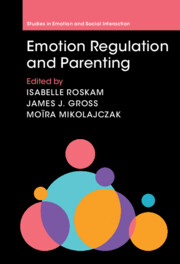Book contents
- Emotion Regulation and Parenting
- Studies in Emotion and Social Interaction
- Emotion Regulation and Parenting
- Copyright page
- Contents
- Figures
- Tables
- Contributors
- Preface
- Part I Conceptual Foundations
- Part II Influence of Parents’ Emotion Regulation on Parenting
- Part III Influence of Parenting on Child Emotion Regulation
- Part IV Current Trends
- Chapter 10 Culture and the Challenges of Being a Good Parent
- Chapter 11 Leveraging Parent–Youth Interactions to Measure and Analyze Emotion Regulation
- Chapter 12 Neurobiology of Parenting and Implications for Emotion Regulation
- Chapter 13 Emotional Labor in Parenting
- Chapter 14 Enhancing Parental Emotion Regulation Skills
- Conclusions and Perspectives
- Index
- Studies in Emotion and Social Interaction
- References
Conclusions and Perspectives
from Part IV - Current Trends
Published online by Cambridge University Press: 05 January 2024
- Emotion Regulation and Parenting
- Studies in Emotion and Social Interaction
- Emotion Regulation and Parenting
- Copyright page
- Contents
- Figures
- Tables
- Contributors
- Preface
- Part I Conceptual Foundations
- Part II Influence of Parents’ Emotion Regulation on Parenting
- Part III Influence of Parenting on Child Emotion Regulation
- Part IV Current Trends
- Chapter 10 Culture and the Challenges of Being a Good Parent
- Chapter 11 Leveraging Parent–Youth Interactions to Measure and Analyze Emotion Regulation
- Chapter 12 Neurobiology of Parenting and Implications for Emotion Regulation
- Chapter 13 Emotional Labor in Parenting
- Chapter 14 Enhancing Parental Emotion Regulation Skills
- Conclusions and Perspectives
- Index
- Studies in Emotion and Social Interaction
- References
Summary
The concluding chapter takes stock of findings and trends in the field, identifies key challenges, and highlights directions and methods for research. It focuses on the imbalance between the three elements comprising the field of emotion regulation in parenting: how parents regulate their own emotions, how parents regulate their own emotions in the context of parenting, and how parents regulate the child’s emotions during parent–child interaction. The most documented of the three is the regulation of the child’s emotions by the parent and its effect on child development. The chapter highlights other shortcomings, such as the importance given to parent-driven effects over child-driven effects, the predominance of correlational studies, and a tendency to simplify by considering the relationships between emotion regulation, parenting, and child development as linear and homogeneous. This chapter proposes future directions focusing on content and methodological issues to overcome the current limitations. Although much work has been done at the intersection of emotion regulation and parenting, much remains to be done. The perspectives proposed should stimulate research in this area.
Keywords
- Type
- Chapter
- Information
- Emotion Regulation and Parenting , pp. 287 - 294Publisher: Cambridge University PressPrint publication year: 2023

